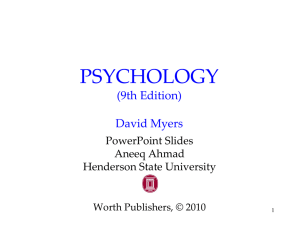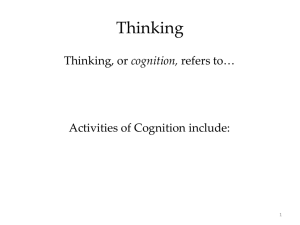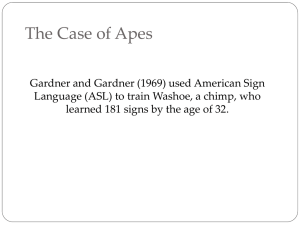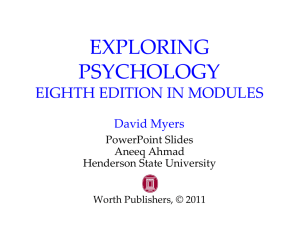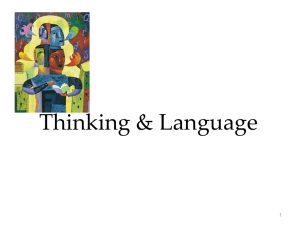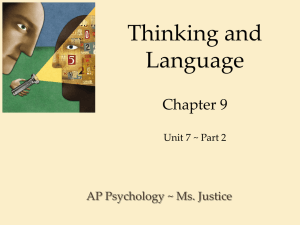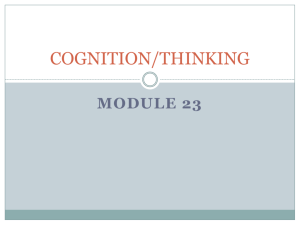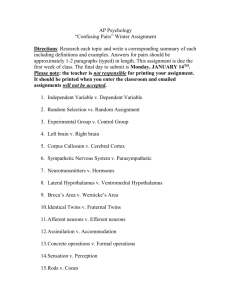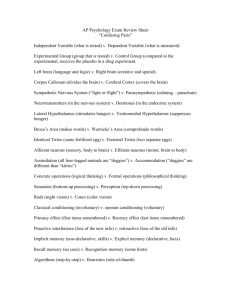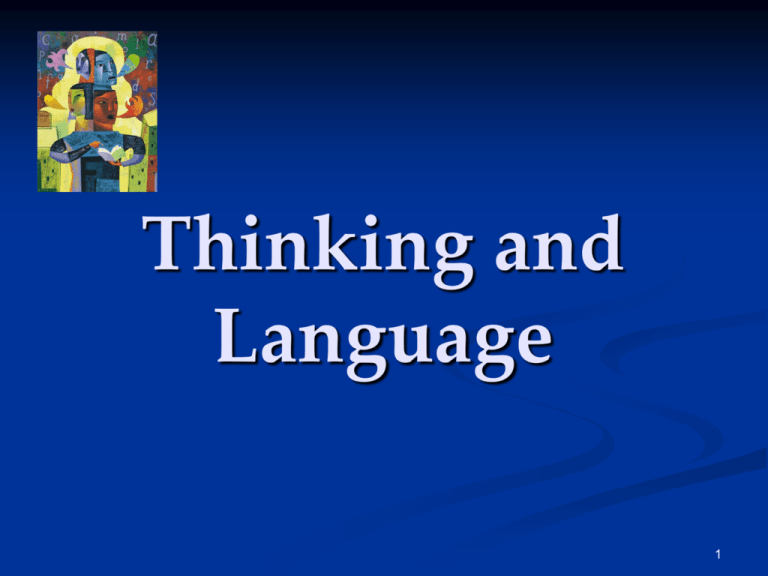
Thinking and
Language
1
Thinking and Language
Thinking
Concepts
Solving Problems
Making Decisions and Forming
Judgments
Belief Bias
2
Thinking
Thinking, or cognition, refers to a process that
involves knowing, understanding,
remembering, and communicating.
3
Cognitive Psychologists
Thinking involves a number of mental
activities, which are listed below. Cognitive
psychologists study these in great detail.
1.
2.
3.
4.
Concepts
Problem solving
Decision making
Judgment formation
4
Concept
The mental grouping of similar objects, events, ideas, or
people. There are a variety of chairs but their common
features define the concept of a chair.
5
Development of Concepts
We form some concepts with definitions. For
example, a triangle has three sides. Mostly, we
form concepts with mental images or typical
examples (prototypes). For example, a robin is
a prototype of a bird, but a penguin is not.
Bird (mental image)
J. Messerschmidt/ The Picture Cube
Daniel J. Cox/ Getty Images
Triangle (definition)
6
Problem Solving
There are different ways to solve problems:
Algorithms: Methodical, logical rules or procedures
that guarantee solving a particular problem.
7
Algorithms
Algorithms, which are very time consuming,
exhaust all possibilities before arriving at a
solution. Computers use algorithms.
SPLOYOCHYG
If we were to unscramble these letters to form a word
using an algorithmic approach, we would face
907,208 possibilities.
8
Heuristics
B2M Productions/Digital Version/Getty Images
Heuristics are simple,
thinking strategies
that allow us to make
judgments and solve
problems efficiently.
Heuristics are less
time consuming, but
more error-prone than
algorithms.
9
Heuristics
Heuristics make it easier for us to use simple
principles to arrive at solutions to problems.
SPLOYOCHYG
S
PP
SL
YO
CH
YO
OC
LH
OGY
Put a Y at the end, and see if the word
begins to make sense.
10
Insight
Insight involves a
sudden novel
realization of a solution
to a problem. Humans
and animals have
insight.
Grande using boxes to
obtain food
11
Insight
Chimpanzees show insightful behavior when
solving problems.
Sultan uses sticks to get food.
12
Insight
From Mark Jung-Beekman, Northwestern
University and John Kounios, Drexel University
Brain imaging and EEG
studies suggest that
when an insight strikes
(the “Aha” experience), it
activates the right
temporal cortex (JungBeeman, 2004). The time
between not knowing the
solution and realizing it
is 0.3 seconds.
13
Obstacles in Solving Problems
Confirmation Bias: A tendency to search for
information that confirms a personal bias.
14
Fixation
Fixation: An inability to see a problem from a
fresh perspective. This impedes problem
solving. Two examples of fixation are mental set
and functional fixedness.
From “Problem Solving” by M. Scheerer. Copyright © 1963 by
Scientific American, Inc. All Rights Reserved.
The Matchstick
Problem: How would
you arrange six
matches to form four
equilateral triangles?
15
Candle-Mounting Problem
Using these materials, how would you mount the
candle on a bulletin board?
From “Problem Solving” by M. Scheerer. Copyright © 1963 by
Scientific American, Inc. All Rights Reserved.
16
The Matchstick Problem: Solution
From “Problem Solving” by M. Scheerer. Copyright © 1963 by
Scientific American, Inc. All Rights Reserved.
17
Candle-Mounting Problem:
Solution
18
Mental Set
A tendency to approach a problem in a
particular way, especially if that way was
successful in the past.
19
Using and Misusing Heuristics
Two kinds of heuristics, representative
heuristics and availability heuristics, have
been identified by cognitive psychologists.
Courtesy of Greymeyer Award, University
of Louisville and Daniel Kahneman
Courtesy of Greymeyer Award, University
of Louisville and the Tversky family
Amos Tversky
Daniel Kahneman
20
Representativeness Heuristic
Judging the likelihood of things or objects in
terms of how well they seem to represent, or
match, a particular prototype.
If you meet a slim, short, man who wears glasses
Probability
that what
that person
a truck
is far
and
likes poetry,
do youisthink
hisdriver
profession
greater
than
league
professor
because
would
be?
An an
Ivyivy
league
professor
or just
a truck
there are more truck drivers than such professors.
driver?
21
Availability Heuristic
Why does our availability heuristic lead us astray?
Whatever increases the ease of retrieving
information increases its perceived availability.
1.
2.
How is retrieval facilitated?
How recently we have heard about the event.
How distinct it is.
22
Making Decision & Forming
Judgments
Deliberative or Automatic?
Each day we make hundreds of judgments and
decisions based on our intuition, seldom using
systematic reasoning.
23
Perils & Powers of Intuition
Intuition may be perilous if unchecked, but
may also be extremely efficient and adaptive.
24
Perils & Powers of Intuition
25
Framing Decisions
Decisions and judgments may be significantly
affected depending upon how an issue is
framed.
Example: What is the best way to market
ground beef — as 25% fat or 75% lean?
26
Belief Bias
The tendency of one’s preexisting beliefs to
distort logical reasoning by making invalid
conclusions.
God is love.
Love is blind
Ray Charles is blind.
Ray Charles is God.
Anonymous graffiti
27
Belief Perseverance
Belief perseverance is the tendency to cling to
our beliefs in the face of contrary evidence.
If you see that a country is hostile, you are likely
to interpret their ambiguous actions as a sign of
hostility (Jervis, 1985).
28
Language
Language, our spoken, written, or gestured work,
is the way we communicate meaning to ourselves
and others.
M. & E. Bernheim/ Woodfin Camp & Associates
Language transmits culture.
29
Grammar
Grammar is the system of rules in a language
that enable us to communicate with and
understand others.
Grammar
Semantics
Syntax
30
Semantics
Semantics is the set of rules by which we derive
meaning from morphemes, words, and
sentences. For example:
Semantic rule tells us that adding –ed to the
word laugh means that it happened in the past.
31
Syntax
Syntax consists of the rules for combining
words into grammatically sensible sentences.
For example:
In English, syntactical rule says that adjectives
come before nouns; white house. In Spanish, it is
reversed; casa blanca.
32
Language Development
Time Life Pictures/ Getty Images
Children learn their
native languages much
before learning to add
2+2.
We learn, on average
(after age 1), 3,500 words
a year, amassing 60,000
words by the time we
graduate from high
school.
33
When do we learn language?
34
Explaining Language Development
1.
Operant Learning: Skinner (1957, 1985)
believed that language development may be
explained on the basis of learning principles
such as association, imitation, and
reinforcement.
35
Explaining Language Development
2. Inborn Universal Grammar: Chomsky (1959,
1987) opposed Skinner’s ideas and suggested
that the rate of language acquisition is so fast
that it cannot be explained through learning
principles, and thus most of it is inborn.
36
Language Influences Thinking
Linguistic Determinism: Whorf (1956) suggested
that language determines the way we think. For
example, he noted that the Hopi people do not
have the past tense for verbs. Therefore, the Hopi
cannot think readily about the past.
37


